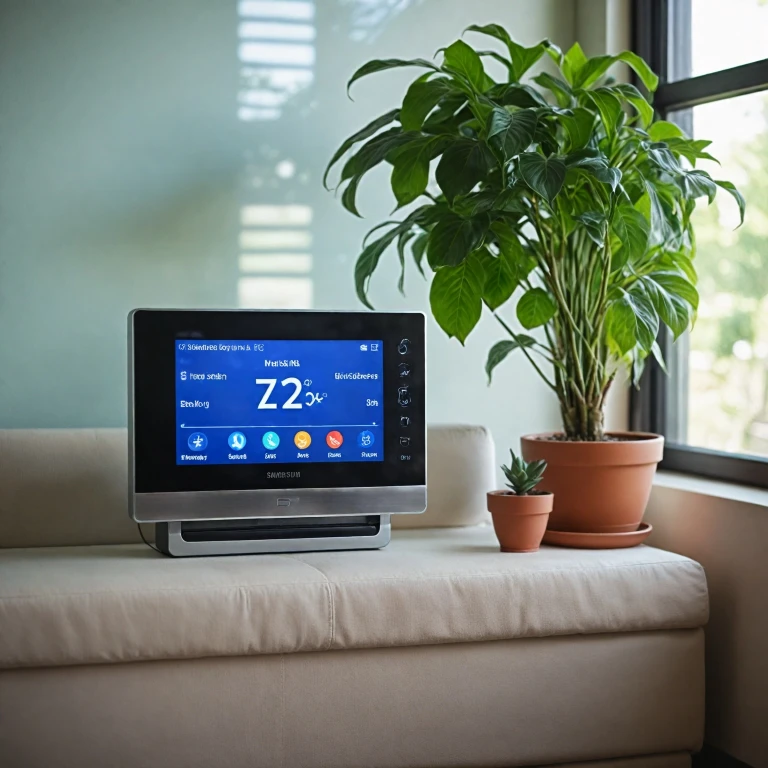Understanding Smart Thermostats
How Do Smart Thermostats Work?
Smart thermostats have revolutionized climate control in homes by offering a level of convenience and efficiency that traditional thermostats simply cannot match. At their core, these devices seamlessly blend with your existing HVAC system, optimizing heating and cooling based on your preferences and habits.
Equipped with WiFi capability, a smart thermostat connects to your home network, allowing you to control the temperature from an app on your smartphone, whether you are on the other side of the house or across the globe. Products like the Nest Learning Thermostat and Ecobee Smart Thermostat are at the forefront of this technology, learning your schedule over time to set temperatures that suit your daily routines automatically.
The Role of Integrated Technologies
Smart thermostats are often paired with voice assistants like Alexa and Google Assistant, enabling voice control for an even more streamlined experience. For instance, with Amazon Alexa or Google Nest, you can adjust the temperature without lifting a finger, making it easy for even the busiest households to maintain comfort effortlessly.
A notable feature is their capability to offer programmable thermostat functions, adapting to your schedule and reducing energy consumption when you're not home. This not only promotes energy savings but also contributes to cost efficiency by lowering your utility bills.
Advantages Beyond Temperature Control
Modern thermostats provide an all-encompassing approach to home comfort. Many models, such as the Google Nest Thermostat, come with features that extend beyond simple temperature settings. These include integration with other smart home devices, compatibility with electric baseboard setups, and even adjusting based on weather data.
In addition, these devices come equipped with various sensors to enhance accuracy and operational efficiency. Understanding how remote sensing thermostats can elevate your comfort level at home is also worth considering. For further insights, you might find
this article on remote sensing thermostats informative.
Benefits of Phone-Controlled Thermostats
Remote Management Made Simple
Smart thermostats are transforming the way we interact with our home heating and cooling systems, fostering a more convenient and energy-efficient lifestyle. With the ability to control your thermostat remotely using a smartphone app, you can maintain the ideal temperature in your home with ease. This innovative technology is a game-changer for those seeking to optimize comfort and save on utility costs.
The convenience of managing your thermostat with your phone cannot be overstated. Whether you are at home or away, you have the flexibility to adjust your home's temperature based on your schedule and preferences. Brands like Nest, Ecobee, and Google Nest offer thermostats that work seamlessly with popular voice assistants like Alexa and Google. This integration allows for hands-free control, which further enhances user experience and accessibility.
Moreover, smart thermostats often come equipped with "smart" features such as learning algorithms that adapt to your heating and cooling preferences over time. For instance, the Nest Learning Thermostat can anticipate your needs, gradually adjusting settings to save energy without compromising on comfort. Such features not only make it easy to manage your indoor climate but also contribute to significant energy savings.
With WiFi connectivity, these thermostats provide real-time updates and notifications, ensuring you are always in control, even from afar. The ability to control your HVAC system remotely means you can return to a warm house in winter or a cool refuge in summer, without having to leave your system running all day. For those using electric baseboard heating or programmable thermostats, upgrading to a smart thermostat can deliver improved energy efficiency and personalized comfort.
Smart thermostat applications typically offer intuitive interfaces, making it easy for users of all tech levels to navigate. They often include features like remote sensing, which enhances comfort by ensuring the temperature is just right where it matters most.
In essence, a phone-controlled thermostat is more than just a product; it represents a step forward in creating a more sustainable and comfortable home environment. These devices provide a blend of technology and convenience that enriches daily life while promoting responsible energy use.
If you're interested in learning more about how remote sensing functionality can enhance your home comfort, explore
enhancing comfort with remote sensing thermostats for detailed insights.
Installation and Compatibility
Installation Made Easy
Setting up a smart thermostat involves several steps, but rest assured, it's designed to be a manageable task even for the less technically inclined. Before you dive into installation, it's crucial to ensure compatibility with your existing heating, ventilation, and air conditioning (HVAC) system. Many smart thermostat models, such as the Nest Thermostat and ecobee Smart Thermostat, come equipped with compatibility check tools that make this step a breeze.
Smart thermostats typically come with a comprehensive installation guide, and many brands also offer video tutorials to help simplify the process. Furthermore, brands like Nest and ecobee have teamed up with professional installers if you prefer expert assistance.
The key steps involve:
- Turning off power: Before beginning, turn off power to your HVAC system to ensure a safe installation.
- Removing the old thermostat: Carefully take out the existing thermostat without damaging wires.
- Labeling wires: As you detach the wires, label them according to their connections to ensure seamless reconnection.
- Mounting the new unit: Follow instructions for mounting the smart thermostat base. This often involves attaching it to your wall with provided screws.
- Connecting wires: Refer to the labels when connecting the wires to the new thermostat.
- Connecting to WiFi: Once wired, you'll connect the thermostat to your WiFi network using the accompanying app. This allows remote temperature control and access to energy-saving features.
To optimize your mini-split with a smart thermostat, review the manufacturer's guidelines or seek professional advice. Connectivity for these devices often extends beyond simple app control. Many models come with additional features like integration with AI voice controls such as "works with Alexa" or "Google Nest" capabilities that further elevate user experience.
In case of electric baseboard heating systems, there are specialized options available, ensuring that you can save energy efficiently across different setups.
By choosing a compatible smart thermostat and carefully following the installation steps, you can pave the way to effortless climate control in your home. More guidance on enhancing your comfort with remote controls can be found
here.
Energy Efficiency and Cost Savings
Enhancing Energy Efficiency with Smart Thermostats
Smart thermostats, like the Nest Learning Thermostat or Ecobee Smart Thermostat, have revolutionized the way we approach home energy efficiency. These devices offer more than just the convenience of controlling temperature via an app on your phone; they significantly contribute to energy savings, a benefit both to your wallet and the environment.
To start, a smart thermostat can learn your schedule and preferences, adjusting the heating and cooling based on whether you're home or away. With features like the Nest thermostat's learning capabilities, you won't need to manually change settings to accommodate your routine—it's all automated.
Additionally, smart thermostats provide insights into your energy usage through their apps, helping you understand and optimize your HVAC system. As a result, heating or cooling your home becomes more efficient and less strenuous on the electric baseboard or other systems, often achieving notable energy savings.
Moreover, some smart thermostats have geofencing capabilities, which means they use your phone's location to determine when you're not home. This feature can significantly reduce unnecessary energy consumption, automatically adjusting temperatures to save energy when the house is empty.
The Environmental Protection Agency (EPA) reports that programmable thermostats, when used properly, can save homeowners about 10-30% on heating and cooling bills annually. With the advent of smart thermostats, these savings can be even more streamlined and effective.
In conclusion, whether you’re employing Amazon Alexa, Google Nest, or another smart home system, upgrading to a smart thermostat is not only an easy way to enhance comfort but also a step towards responsible energy use.
Security and Privacy Concerns
Securing Your Smart Climate System
When integrating smart thermostats into your home, security and privacy are paramount. With the convenience of controlling your HVAC system via an app on your phone, such as the Nest thermostat or Ecobee smart thermostat, ensuring your data safety is crucial.
Smart thermostats operate over WiFi, enabling you to control temperature settings effortlessly. But with this connectivity comes the risk of unauthorized access to your system. Here are several critical areas to consider:
- Secure Your Network: A robust, password-protected WiFi network is the first line of defense against potential intrusions. Consider using WPA3 encryption for enhanced security.
- Update Firmware Regularly: Manufacturer updates often include security patches. Regularly updating your thermostat smart device, whether it's from Google, Amazon, or another brand, is vital.
- Two-Factor Authentication: Where possible, enable two-factor authentication for the apps controlling your energy settings. This adds an additional layer of security, ensuring only authorized users can access the system.
- Be Mindful of Data Sharing: Smart thermostats often collect usage data to optimize performance. Reviewing privacy settings and understanding what data is shared with manufacturers like Nest or Ecobee is essential.
Managing the security and privacy of your smart thermostat not only ensures your comfort but also protects your home from potential digital threats. With careful consideration, you can enjoy the benefits of your newly acquired or month-bought smart system while maintaining peace of mind.
Choosing the Right Smart Thermostat
Selecting the Right Smart Thermostat for Your Needs
Choosing the perfect smart thermostat can indeed be overwhelming given the diverse range of products available in the market. However, investing time in research will lead to enhanced comfort and significant energy savings. Here are some factors to consider when choosing a smart thermostat:
- Compatibility with HVAC System: Ensure the thermostat is compatible with your existing HVAC system. For instance, if you have electric baseboard heating, you'll need a specific type of thermostat that supports it.
- Control Options: Check if the thermostat supports mobile app control, allowing convenient management of home temperature via smartphones. Many prefer those that also work with Alexa, Google, or Amazon voice assistants for hands-free control.
- Energy Efficiency Features: Many smart thermostats, such as the Nest Learning Thermostat and Ecobee Smart, are known for their energy-saving capabilities. They often come with features that adapt to your schedule and preferences, offering potential savings on your energy bill.
- Ease of Use: Look for models that are easy to install and user-friendly. A thermostat that has a straightforward interface, both on the device itself and its app, will make it easier to adjust the settings as needed.
- Additional Features: Some thermostats come equipped with advanced features such as remote sensors to measure and adjust the temperature in different rooms, ensuring comfortable heating and cooling throughout the house.
Remember to also check customer reviews and product ratings—5-star reviews usually indicate satisfaction and reliability. Brands like Google Nest and Ecobee often receive high praise for their performance and innovative features, making them a popular choice among consumers.
With these considerations, you’ll be well-equipped to choose a thermostat that meets your specific needs and enhances your home’s climate control system efficiently.

